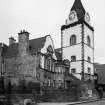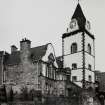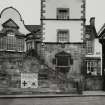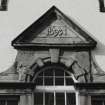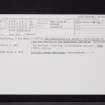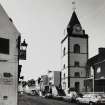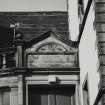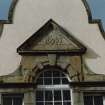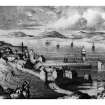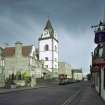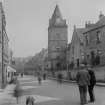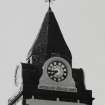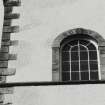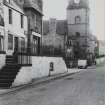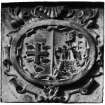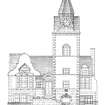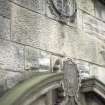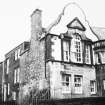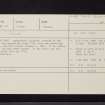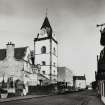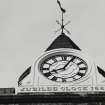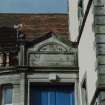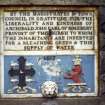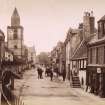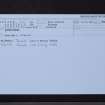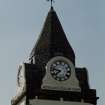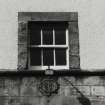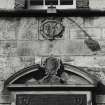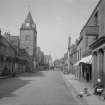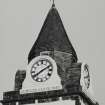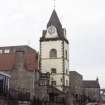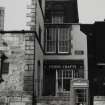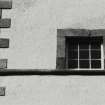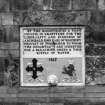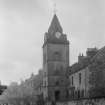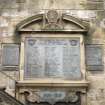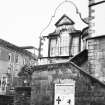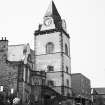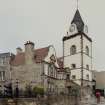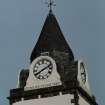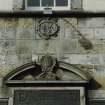South Queensferry, High Street, Tolbooth
Tolbooth (18th Century), Town Hall (18th Century), War Memorial(S) (20th Century) (1927)
Site Name South Queensferry, High Street, Tolbooth
Classification Tolbooth (18th Century), Town Hall (18th Century), War Memorial(S) (20th Century) (1927)
Alternative Name(s) South Queensferry Town Hall; Queensferry Tolbooth; Tolbooth Tower; War Memorial Plaques; Queensferry War Memorial
Canmore ID 50562
Site Number NT17NW 24
NGR NT 12951 78356
Datum OSGB36 - NGR
Permalink http://canmore.org.uk/site/50562
- Council Edinburgh, City Of
- Parish Dalmeny
- Former Region Lothian
- Former District City Of Edinburgh
- Former County West Lothian
NT17NW 24 12951 78356
Remodelled: c.1720.
(Undated) information in NMRS.
(NT 1295 7835) Queensferry Tolbooth, erected in the 17th c, was remodelled about 1720, when the tower was erected, and was further altered c.1890. It is rubble-walled, and the front harled. in the tower are two bells, dated 1694 and 1723.
RCAHMS 1929, visited 1926; SDD List 1963
As described.
Visited by OS (BS) 15 August 1974
The Queensferry tollbooth (Category A and Scheduled) was erected in the 17th century, remodelled in 1720, with the addition of the tower, and later altered c 1890. The tollbooth is a three storey building with a clock dating to 1887 at the top.
Site recorded by GUARD during the Coastal Assessment Survey for Historic Scotland, 'The Firth of Forth from Dunbar to the Coast of Fife' 18th February 1996.
(Formerly scheduled as South Queensferry, tolbooth). Descheduled.
Information from Historic Scotland: Certificate of Exclusion from Schedule dated 11 November 2003.
Publication Account (1996)
The tolbooth stands on a raised terrace on the S side of High Street, its prominence enhanced by later lowering of the street level. It comprises a main block of 17th-century origin, and a five-storeyed steeple of 1720 projecting at the N front. A forestair rising along the Nand E walls of the steeple gives access from street level to the terrace and to the first-floor entrance of the main block. The building is constructed of a combination of harled rubble and dressed sandstone, and the roof of the main block is tiled to the front like that of the adjacent Rosebery Memorial Hall of 1893.
The main block has been rectangular on plan, measuring 5.5m in depth, but because of rebuilding to the E in 1893 only about 10m of its length is preserved. The entrance-area, dormer-windows and chimneys were altered at the same time. The central and W portions of the ground storey, including two doorways with chamfered surrounds in the N wall, may be ascribed to the 17th century. The W part of this storey was in use as a weigh-house by 1641, housing a beam and weights imported from Holland, while the remainder probably served as a prison. I The first floor was extensively altered in the 18th century, and in 1770 it was fitted up as a new court-room and a council-chamber. Despite its limited size the first floor of the steeple was also used as a court-room, its fittings surviving as late as the 1890s, and in 1813 the ringing-chamber was converted to a writing-office for the town clerk.
The lower part of the N front of the steeple at ground-floor level is built of sandstone ashlar, as are the rusticated quoins, the window-margins and the moulded string-courses dividing the stages, while the remainder is harled. A small oval panel in the N wall below the first-floor string-course bears the burgh arms within mantling of 18th-century character. The existing octagonal slate-hung belfry and slated spire date from 1807, but the belfry was altered in 1888 to house a new clock and large clock-faces commemorating the jubilee of Queen Victoria.
The walls enclosing the passage through the steeple at the level of the terrace were constructed in 1832, and the arches in its E and W walls may have been altered at the same time, but a reference of that date to the' Steeple Pillars' suggests that there was always public access through its base. A cast-iron plaque attached to the forestair records that in 1817 the 4th Earl of Rosebery, then provost of the burgh, provided a water supply and a bleaching green for its inhabitants. The cistern for one of the wells was placed beneath the forestair, which was evidently rebuilt at this time. The channelled quoins of the steeple begin at the level of the terrace, suggesting that the street-level was also lowered at this time.
The steeple houses a bell 0.54m in diameter, inscribed: EXDONO HENRJCJ CVNJNGHAME DE BOQUHAN 1723. In 1927 it also contained another bell, 0.37m in diameter and bearing the incised inscription: THE SEAMEN OF QVEENSFERRIE DID GIFT THIS BELL TO THE TOWNE ANNO 1694 ADRIAEN DOP FECIT. This bell was removed from Bailie John Syme's house in 1750 to be hung in the tolbooth, but it is now in the tower of the nearby Episcopal church.
HISTORY
A tolbooth was in existence at South Queensferry by 1635, and in 1649 its repair was the subject of an application to the Convention of Royal Burghs.A new door 'at the foot of the tolbooth stair', to give access from the street to the 'thieves' hole', was added in 1703,9 but its exact position cannot be determined.
Substantial rebuilding took place in 1720 when the present steeple was erected. Its construction was financed by Henry Cunningham of Boquhan, MP for Stirling Burghs, who also provided a new clock and bell, and in 1732 the' floors of the steeple were strengthened to support the weight of the clock. Further repairs were carried out in 1740 to prevent the building 'going entirely to ruin'. In 1770 the first floor of the main block was fitted out as a new court-room and council-chamber, divided by a wall which in 1784 was replaced by a moveable partition.
In 1893 the 5th Earl of Rosebery gifted the adjacent hall, set at a slight angle to the E of the main block, as a memorial to his wife Hannah (d. 1890). It was designed in an Arts and Crafts style by the Edinburgh architects Sydney Mitchell and Wilson, to provide rooms for reading, games and smoking in addition to a small auditorium.
Information from ‘Tolbooths and Town-Houses: Civic Architecture in Scotland to 1833’ (1996).
Project (1997)
The Public Monuments and Sculpture Association (http://www.pmsa.org.uk/) set up a National Recording Project in 1997 with the aim of making a survey of public monuments and sculpture in Britain ranging from medieval monuments to the most contemporary works. Information from the Edinburgh project was added to the RCAHMS database in October 2010 and again in 2012.
The PMSA (Public Monuments and Sculpture Association) Edinburgh Sculpture Project has been supported by Eastern Photocolour, Edinburgh College of Art, the Edinburgh World Heritage Trust, Historic Scotland, the Hope Scott Trust, The Old Edinburgh Club, the Pilgrim Trust, the RCAHMS, and the Scottish Archive Network.
Field Visit (8 October 2002)
Tolbooth and square tower on top of which is a four-faced clock, erected to commemorate Queen Victoria's Golden Jubilee. On the lower part of the tower (built 1720) is a carved relief of the Queensferry arms (St Margaret on the right (W), cross and birds on the left (E))
H & R Milbar, Castle Bank Works were clockmakers. Robert Brown (of Forth Bridge Works) was the architect of the Jubilee Clock.
Inspected By : T.S.
Inscriptions : Below clock (raised letters) on each side of building:
JUBILEE CLOCK 1887
Signatures : None
Design period : Tolbooth 1636; remodelled 1720. Jubilee Clock 1887
Information from Public Monuments and Sculpture Association (PMSA Work Ref : EDIN1143)
Field Visit (8 October 2002)
Wall fountain within two rectangular panels one above the other. The top panel contains an inscription, the bottom the arms of Queensferry (cross and birds) and the Rosebery arms (half-length lion rampant holding a rose in its right paw, a crown above its head). At the bottom of the lower panel is a lion's head in high relief [a water spout?]
Archibald John, 4th Earl of Rosebery (1783-1868)
Inspected By : T.S.
Inscriptions : Within upper panel (painted raised letters):
BY THE MAGISTRATES & TOWN / COUNCIL IN GRATITUDE FOR THE / LIBERALITY AND KINDNESS OF / ARCHIBALD JOHN EARL OF ROSEBERY / PROVOST OF THIS BURGH TO WHOM / THE INHABITANTS ARE INDEBTED / FOR A BLEACHING GREEN & THIS / SUPPLY OF WATER
At top of lower panel (painted raised numbers) : 1817
On banner below arms of Queensferry (painted raised letters): PASSAGIA REGINA
On banner below Rosebery arms (painted raised letters): FIDE ET FIDUCIA
Signatures : None
Design period : 1817
Information from Public Monuments and Sculpture Association (PMSA Work Ref : EDIN1144)
Field Visit (8 October 2002)
War memorial composed of a broken segmental pediment (top) within which is an oval panel carved with the Queensferry arms (St Margaret in boat), a central bronze inscription panel and a base containing a date panel. To either side is an inscription panel containing the names of fallen from World War II and, below each, a date panel.
Inspected By : T.S.
Inscriptions : On main panel (in raised letters):
IN MEMORY OF THE MEN / OF QUEENSFERRY / WHO FELL IN THE GREAT WAR [and list of names below]
On two smaller panels (in raised letters) a list of names
On date panels (raised numbers): 1914-1918 (main), 1939-1945 (sides)
Signatures : None
Information from Public Monuments and Sculpture Association (PMSA Work Ref : EDIN1146)





















































